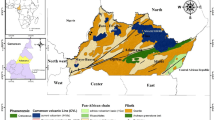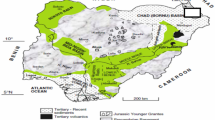Abstract
The bottom of the magnetized crust determined from the spectral analysis of magnetic anomaly is interpreted as a level of the Curie point isotherm. A spectral analysis technique was used to estimate the depth of the magnetic anomalies sources (Curie point depth analysis) of the eastern shore of the Gulf of Suez, Egypt. The depth to the tops and centers of the magnetic anomalies are calculated by azimuthally averaged power spectrum method for the whole area. The results obtained suggests from this study showed that the average depth to the top of the crustal block ranges between 1.15 and 1.9 km, whereas the average depth to the center of the deepest crustal block ranges between 9.1 and 12.7 km. Curie point depths in the study area range between 14.5 km in the northwestern part of the study area and 26 km in the southeastern part of the study area. The results imply a high geothermal gradient (34.7 °C/km) and corresponding high heat flow value (72.87 mW/m2) in the northwestern part of the study area. The southeastern part of the study area displays a low geothermal gradient (24.26 °C/km) and low heat flow value (50.9 mW/m2). These results are consistent with the existence of the possible promising geothermal reservoir in the eastern shore of the Gulf of Suez especially at Hammam Faraun area.










Similar content being viewed by others
References
Abdel Zaher M, El Nouby M, Ghamry E, Ehara S (2010) Contribution of geophysical and temperature logs data to geothermal exploration on the Gulf of Suez. Egypt Proceedings World Geothermal Congress, Bali, pp 25–29
Abdel Zaher M, Nishijima J, El-Qady G, Aboud E, Masoud O, Soliman M, Ehara S (2011a) Gravity and magnetotelluric investigations to elicit the origin of Hammam Faraun hot spring, Sinai Peninsula, Egypt. Acta Geophysica 59(3):633–656
Abdel Zaher M, Saibi H, El Nouby M, Ghamry E, Ehara S (2011b) A preliminary regional geothermal assessment of the Gulf of Suez, Egypt. J Afr Earth Sci 60:117–132
Abd El Nabi SH (2012) Curie point depth beneath the Barramiya-Red Sea coast area estimated from aeromagnetic spectral analysis. J Asian Earth Sci 43:254–266
Aboud A, Salem A, Mekkawi M (2011) Curie depth map for Sinai Peninsula, Egypt deduced from the analysis of magnetic data. Tectonophysics 506:46–54
Abul Nasr R (1987) Biostratigraphy and facies analysis of some Eocene exposures in west Central Sinai. [PhD thesis], University of South Carolina, Egypt
Al-Zoubi A (1992) Deep geologic composition of Jordan by geophysical data, Ph.D. thesis, Mining Institute. Sankt-Petersburg (in Russian)
Aydın I, Karat I, Koçak A (2005) Curie-point depth map of Turkey, geophysics. J Int 162:633–640
Bansal A, Gabriel G, Dimri V (2010) Depth to the bottom of magnetic sources in Germany. EGM 2010 International Workshop Adding new value to Electromagnetic, Gravity and Magnetic Methods for Exploration Capri, Italy
Bhattacharyya K (1966) Continuous spectrum of the total magnetic field anomaly due to a rectangular prismatic body. Geophysics 31:97–121
Bhattacharyya BK, Morley LW (1965) The delineation of deep crustal magnetic bodies from total field aeromagnetic anomalies. J Geomagn Geoelectr 17:237–252
Blakely R (1988) Curie temperature isotherm analysis and tectonic implications of aeromagnetic data from Nevada. J Geophys Res 93:817–832
Blakely R (1995) Potential theory in gravity and magnetic applications. Cambridge University Press, Cambridge
Blackwell DD (1971) The thermal structure of the continental crust. In: Heacock JD (ed) The structure and physical properties of the earth’s crust: AGU, Geophys Monogr Ser vol. 14: pp. 169–184
Boulos F (1990) Some aspects of the geophysical regime of Egypt in relation to heat flow, groundwater and microearthquakes. In: Said R 1990 (ed) The geology of Egypt. 407–438, Balkema, Rotterdam
Büyüksaraç A Bekta S (2007) Curie point depth of inner East Anatolia (Turkey) Geophysical Research Abstracts, Vol. 9, 00384, 2007SRef-ID: 1607-7962/gra/EGU2007-A-00384
Byerly P, Stolt RH (1977) An attempt to define the Curie point isotherm in northern and central Arizona. Geophysics 42:1394–1400
Cianciara B, Marcak H (1976) Interpretation of gravity anomalies by means of local power spectra. Geophys Prospect 24:273–286
Connard G, Couch R, Gemperle M (1983) Analysis of aeromagnetic measurements from the Cascade Range in central Oregon. Geophysics 48:376–390
Deming D (1994) Overburden rock, temperature and heat flow In: Magoon LB and Dow WG (eds) The petroleum system-from source to trap: AAPG Memoir 60:165–186
Egyptian National Seismological Network (ENSN) (2007) Annual seismological bulletin. National Research Institute of Astronomy and Geophysics, Cairo
Eppelbaum LV, Pilchin AN (2006) Methodology of Curie discontinuity map development for regions with low thermal characteristics: an example from Israel. Earth Planet Sci Lett 243:536–551
Espinosa-Cardena JM, Campos-Enriqez JO (2008) Curie point depth from spectral analysis of aeromagnetic data from Cerro Prieto geothermal area, Baja California, México. J Volcanol Geotherm Res 176(4):601–609
Feinstein S, Kohn B, Steckler M, Eyal M (1996) Thermal history of the eastern margin of the Gulf of Suez. I. Reconstructed from borehole temperature and organic maturity measurements. Tectonophysics 266:203–220
Francisco R, Antonio I (2003) Curie point depths beneath Precordillera Cuyana and Sierras Pampeanas obtained from spectral analysis of magnetic anomalies. Gondwana Res 7(4):1133–1142
Gawthorpe RL, Jackson CAL, Young MJ, Sharp IR, Moustafa AR, Leppard C (2003) Fault growth interaction linkage and death: evolution of the Hammam Faraun fault block, Suez Rift, Egypt. J Struct Geol 25:883–895
Geosoft Program (Oasis Montaj) (2007) Geosoft mapping and application system, Inc, Suit 500, Richmond St. West Toronto, ON Canada N5SIV6
Hamdy SS, Rashad SM, Blank HR (1984) Spectral analysis of aeromagnetic profiles for depth estimation principles, software, and practical application: U. S. Geological Survey, Open-File Report, 84–0849
Hosney HM, Morgan P (2000) Geothermal behavior and tectonic setting in the Northern Gulf of Suez, Egypt. J Environ Sci 19:55–74
Ismail AM, Sultan SA, Mohamady MM (2001) Bouguer and total magnetic intensity of Sinai Peninsula, Scale 1:500.000. Proc 2nd International Symposium on Geophysics, Tanta, P 111–117
Jackson CAL, Gawthorpe RL, Sharp IR (2002) Growth and linkage of the East Tanka fault zone; Suez rift: structural style and syn-rift stratigraphic response. J Geol Soc 159(2):175–187
Lashin A, Al Arifi N (2010) Some aspects of the geothermal potential of Egypt case study: Gulf of Suez-Egypt. Proceedings World Geothermal Congress 2010 Bali, Indonesia
Maden N (2009) Crustal thermal properties of the Central Pontides (northern Turkey) deduced from spectral analysis of magnetic data. Turk J Earth Sci 18:383–392
Manea M, Constantin V (2011) Curie point depth estimates and correlation with flat-slab subduction in Mexico. Geophysical Research Abstracts Vol. 13, EGU2011-6995
Maus S, Gordon D, Fairhead JD (1997) Curie-temperature depth estimation using a self-similar magnetization model. Geophys J Int 129:163–168
Mishra DC, Naidu PS (1974) Two-dimensional power spectral analysis of aeromagnetic fields. Geophys Prospect 22:345–353
Morgan P, Swanberg CA (1979) Heat flow and the geothermal potential of Egypt. Birkhauser Verlag, Basel Pageoph 117:213–225
Morgan P, Swanberg CA, Boulos FK, Hennin SF, El-Sayed AA, Basta NZ (1980) Geothermal studies in northeast Africa. Annals Geol Surv Egypt 10:971–987
Morgan P, Boulos FK, Swanberg CA (1983) Regional geothermal exploration in Egypt. EAEG 31:361–376
Morgan P, Boulos FK, Hennin S, El-Sheriff A, Sayed A, Basta N, Melek Y (1985) Heat flow in eastern Egypt: the thermal signature of a continental breakup. J Geodyn 4:107–131
Moustafa AR (1993) Structural characteristics and tectonic evolution of the east margin blocks of the Suez rift. Tectonophysics 223:281–299
Nettleton LL (1976) Gravity and magnetic in oil prospecting. McGraw-Hill Book Co. Inc, New Yourk, 464p
Ogawa Y (1992) Deep crustal resistivity structure revealed by wide-band magnetotellurics. Tohoku and Hokkaido Region, [Ph.D. Thesis] Univ of Tokyo, Japan
Ogawa Y, Mishina M, Goto T, Satoh H, Oshiman N, Kasaya T, Takahashi Y, Nishitani T, Sakanaka S, Uyeshima M, Takahashi Y, Honkura Y, Matsushima M (2001) Magnetotelluric imaging of fluids in intraplate earthquake zones, NE Japan back arc. Geophys Res Lett 28:3741–3744
Okubo Y, Graf RJ, Hansen RO, Ogawa K, Tsu H (1985) Curie point depths of the island of Kyushu and surrounding areas, Japan. Geophysics 50:481–494
Okubo Y, Matsushima J, Correia A (2003) Magnetic spectral analysis in Portugal and its adjacent seas. Phys Chem Earth 28:511–519
Omanda P (2007) The geothermal activity of the East African rift. Short course II on surface exploration for Geothermal Resources, organized by UNU-GTP and KenGen, at Lake Naivasha, Kenya, November 2011
Patton TL, Moustafa AR, Nelson RA, Abdeen SA (1994) Tectonic evolution and structural setting of the Suez Rift. AAPG Mem 59:9–51
Phillips JD (1997) ‘Potential-field geophysical software for the PC, version 2.2’, US. Geological Survey, Open-File Report 97–725
Rama Rao C, Kishore RK, Pradeep Kumar V, Butchi Babu B (2011) Delineation of intra crustal horizon in Eastern Dharwar Craton—an aeromagnetic evidence. J Asian Earth Sci 40:534–541
Ruiz F, Introcaso A (2004) Curie point depths beneath Precordillera Cuyana and sierras Pampeanas obtained from spectral analysis of magnetic anomalies. Gondwana Res 7(4):1133–1142
Ross H, Blakely R, Zobak M (2006) Testing the utilization of aeromagnetic data for the determination of Curie-isotherm depth. Fall Meet. Suppl., Abstract T31A-1287, vol. 85.EOS Trans. Am. Goephys. Un
Said R (1962) The Geology of Egypt. Elsevier, Amstredam, p 377 pp
Selim EI, Aboud E (2012) Determination of sedimentary cover and structural trends in the Central Sinai area using gravity and magnetic data analysis. J Asian Earth Sci 43:193–206
Salem A, Ushijima K, Elsirafi A, Mizunaga H (2000) Spectral analysis of aeromagnetic data for geothermal reconnaissance of Quseir area, Northern Red Sea, Egypt. Proc. of the World Geothermal Congress, Japan, pp 1669–1674
Sharp I, Gawthorpe R, Armstrong B, Underhill J (2000) Propagation history and passive rotation of mesoscale normal faults: implications for syn-rift stratigraphic development. Basin Res 12:285–306
Shuey RT, Schellinger DK, Tripp AC, Alley LB (1977) Curie depth determination from aeromagnetic spectra. Geophys J R Astron Soc 50:75–101
Spector A, Grant FS (1970) Statistical models for interpreting aeromagnetic data. Geophysics 35:293–302
Stampolidis A, Tsokas GN (2002) Curie point depths of Macedonia and Thrace. N. Greece. Pure Appl Geophys 159:2659–2671
Stampolidis A, Kane I, Tsokas GN, Tsourlo P (2005) Curie point depths of Albania inferred from ground total field magnetic data. Surv Geophys 26:461–480
Tanaka A, Okubo Y, Matsubayashi O (1999) Curie point depth based on spectrum analysis of the magnetic anomaly data in East and Southeast Asia. Tectonophysics 306:461–470
Tezcan AK (1979) Geothermal studies, their present status and contribution to heat flow contouring in Turkey. In: Cermak V, Rybach L (eds) Terrestrial heat flow in Europe. Springer, Berlin, pp 283–291
Trifonova P, Zhelev Z, Petrova T, Bojadgieva K (2009) Curie point depths of Bulgarian territory inferred from geomagnetic observations and its correlation with regional thermal structure and seismicity. Tectonophysics 473:362–374
Tselentis A (1991) An attempt to define Curie point depths in Greece from aeromagnetic and heat flow data, PAGEOPH, 136 (l)
Tsokas GN, Hansen RO, Fytikas M (1998) Curie point depth of the island of Crete (Greece). Pure Appl Geophys 152:747–757
Turcotte DL, Schubert G (1982) Geodynamics applications of continuum physics to geologic problems. Wiley, New York
Yamano M (1995) Recent heat flow studies in and around Japan. In: Gupta ML, Yamano M (eds) Terrestrial heat flow and geothermal energy in Asia. A.A. Balkema, Rotterdam, pp 173–201
Acknowledgments
The authors are indebted to all staff members in Geology Departments, Faculty of Science at Damietta, Damietta University, for their beneficial comments on my manuscript, continuous help, and support during the progress of this research.
Author information
Authors and Affiliations
Corresponding author
Rights and permissions
About this article
Cite this article
Selim, E.I., Aboud, E. Application of spectral analysis technique on ground magnetic data to calculate the Curie depth point of the eastern shore of the Gulf of Suez, Egypt. Arab J Geosci 7, 1749–1762 (2014). https://doi.org/10.1007/s12517-013-0868-7
Received:
Accepted:
Published:
Issue Date:
DOI: https://doi.org/10.1007/s12517-013-0868-7




